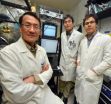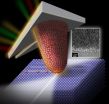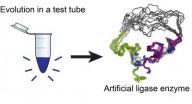(Press-News.org) AUGUSTA, Ga. – Scientists have found an early step in how the brain's inhibitory cells get excited.
A natural balance of excitement and inhibition keeps the brain from firing electrical impulses randomly and excessively, resulting in problems such as schizophrenia and seizures. However excitement is required to put on the brakes.
"When the inhibitory neuron is excited, its job is to suppress whatever activity it touches," said Dr. Lin Mei, Director of the Institute of Molecular Medicine and Genetics at the Medical College of Georgia at Georgia Regents University and corresponding author of the study in Nature Neuroscience.
Mei and his colleagues found that the protein erbin, crucial to brain development, is critical to the excitement.
It was known that a protein on the cell surface called TARP gamma-2, also known as stargazing, interacts with a brain cell receptor called AMPA, ensuring the receptor finds the cells surface. It is here that the receptor can be activated by the neurotransmitter glutamate. AMPA receptor activation is essential to activation of the NMDA receptor, which enables cells to communicate, ultimately enabling learning and memory, Mei said. How TARP gamma-2 was controlled, was an unknown.
Inside the nucleus of inhibitory cells in areas of the brain that control learning and memory, the researchers found erbin interacts with TARP gamma-2, enabling it to survive. "If you do not have this mechanism, your stargazing becomes very unstable and your AMPA receptor cannot be on the surface so this neuron is inactive," Mei said. They also found that erbin is only in these inhibitory neurons, called interneurons. They're already working on what they believe to be the counterpart for excitatory cells, which account for about 80 percent of brain cells.
"Interneurons basically control firing," releasing GABA, a major inhibitory neurotransmitter, Mei said. They tone down or synchronize the activity of pyramidal cells, pyramid-shaped neurons that get both excitatory and inhibitory input then make the call on what action to take.
When scientists ablated the erbin gene in mice or kept erbin from interacting with TARP gamma-2, a protein that helps anchor the AMPA receptor on the cell surface, TARP gamma-2 couldn't do its job. The result was less receptors on the cell surface and mice that were hyperactive with impaired learning and memory.
Cell activity hinges on receptor activity and receptors must be anchored on the cell surface to work. Ensuring AMPA receptors are strategically placed is a lifelong task since the busy receptors wear out and each brain cell has tons of them, Mei said.
He and his colleagues reported in the journal, Neuron, in 2007, two genes – neuregulin-1 and its receptor ErbB4 – that help maintain a healthy balance of excitement and inhibition by releasing GABA at the sight of inhibitory synapses, the communication paths between neurons. Years before, they showed the genes were also at excitatory synapses, where they also could quash activation. Both genes are involved in human development and implicated in schizophrenia and cancer.
INFORMATION:
Mei is a Georgia Research Alliance Eminent Scholar in Neuroscience.
Scientists learn more about how inhibitory brain cells get excited
2013-01-30
ELSE PRESS RELEASES FROM THIS DATE:
A new genre of 'intelligent' micro- and nanomotors
2013-01-30
Enzymes, workhorse molecules of life that underpin almost every biological process, may have a new role as "intelligent" micro- and nanomotors with applications in medicine, engineering and other fields. That's the topic of a report in the Journal of the American Chemical Society, showing that single molecules of common enzymes can generate enough force to cause movement in specific directions.
Peter J. Butler, Ayusman Sen and colleagues point out that enzymes — proteins that jump-start chemical reactions — are the basis of natural biological motors essential to life. ...
Penn research shows mechanism behind wear at the atomic scale
2013-01-30
PHILADELPHIA — Wear is a fact of life. As surfaces rub against one another, they break down and lose their original shape. With less material to start with and functionality that often depends critically on shape and surface structure, wear affects nanoscale objects more strongly than it does their macroscale counterparts.
Worse, the mechanisms behind wear processes are better understood for things like car engines than nanotech devices. But now, researchers at the University of Pennsylvania's School of Engineering and Applied Science have experimentally demonstrated ...
Researchers improve medical units to reduce nursing fatigue, cut costs
2013-01-30
ITHACA, N.Y. – In hospitals, poor floor design, storage closet clutter and crowded corridors can contribute to nurse and medical staff fatigue. These distractions can hurt patient care quality and result in higher medical costs.
Now, a new Cornell University study offers a spatial solution.
Rana Zadeh, Cornell assistant professor of design and environmental analysis in the College of Human Ecology, analyzed the floor plans and work patterns within five medical-surgical units at U.S. hospitals and found numerous opportunities to boost nurses' efficiency through better ...
Conflicting cultural identities may foster political radicalism
2013-01-30
New research suggests that dual-identity immigrants — first-generation immigrants and their descendants who identify with both their cultural minority group and the society they now live in — may be more prone to political radicalism if they perceive their two cultural identities to be incompatible.
The new research is published in Psychological Science, a journal of the Association for Psychological Science.
Psychological scientist Bernd Simon from Kiel University in Germany and colleagues hypothesized that perceived incompatibility between the two cultural identities ...
Aging cells lose their grip on DNA rogues
2013-01-30
PROVIDENCE, R.I. [Brown University] — Even in our DNA there is no refuge from rogues that prey on the elderly. Parasitic strands of genetic material called transposable elements — transposons — lurk in our chromosomes, poised to wreak genomic havoc. Cells have evolved ways to defend themselves, but in a new study, Brown University researchers describe how cells lose this ability as they age, possibly resulting in a decline in their function and health.
Barbara McClintock, awarded the Nobel Prize in 1983, made the original discovery of transposons in maize. Since then ...
GEOLOGY starts 2013 with 25 new articles posted online ahead of print
2013-01-30
Boulder, Colo., USA - Geology content posted online 4 through 25 January 2013 cover topics from greenhouse gas emissions to video observations of erupting geysers in Russia and from the age of Earth to the age of Grand Canyon. Highlights and detailed information about each article are listed below.
1. Earth is mostly flat
2. Age maps of early Earth
3. Sagaing fault, Indo-Burmese wedge
4. Anthropogenic lead
5. The growth of a newly born submarine volcano
6. The Hemlo gold deposit, Ontario, Canada
7. Reptile and mammal fossils in the Karoo Basin, South Africa
8. ...
U. of Minn. researchers unveil first artificial enzyme created by evolution in a test tube
2013-01-30
There's a wobbly new biochemical structure in Burckhard Seelig's lab at the University of Minnesota that may resemble what enzymes looked like billions of years ago, when life on earth began to evolve – long before they became ingredients for new and improved products, from detergents to foods and fuels.
Seelig created the fledgling enzyme by using directed evolution in the laboratory. Working with colleague Gianluigi Veglia, graduate student Fa-An Chao, and other team members, he subsequently determined its structure, which made its debut December 9 as an advance online ...
Researchers develop model for identifying habitable zones around star
2013-01-30
UNIVERSITY PARK, Pa. -- Researchers searching the galaxy for planets that could pass the litmus test of sustaining water-based life must find whether those planets fall in a habitable zone, where they could be capable of having liquid water and sustaining life. New work, led by a team of Penn State researchers, will help scientists in that search.
Using the latest data, the Penn State Department of Geosciences team has developed an updated model for determining whether discovered planets fall within a habitable zone. The work builds on a prior model by James Kasting, ...
Reconcilable differences: Study uncovers the common ground of scientific opposites
2013-01-30
Searching for common elements in seemingly incompatible scientific theories may lead to the discovery of new ones that revolutionize our understanding of the world.
Such is the idea behind a mathematical framework Princeton University researchers developed that strips away the differences between scientific laws and theories to reveal how the ideas are compatible. In a recent report in the journal Physical Review Letters, the authors explain how the mathematical model finds common ground between the famously at-odds physics equations that govern classical and quantum ...
Mindfulness meditation heightens a listener's musical engagement
2013-01-30
EUGENE, Ore. -- (Jan. 30, 2013) -- When De'Anthony Thomas returned the opening kickoff for a touchdown in the 2013 Fiesta Bowl, says University of Oregon researcher Frank Diaz, Thomas put Ducks fans into a heightened zone of engagement for watching the game, not unlike what was experienced by music students who were first exposed to a brief session of mindfulness meditation before hearing an opera passage.
As a high school orchestra and band educator in Florida, Diaz had flirted with yoga and light meditation in a quest to heighten music engagement. He noticed, anecdotally, ...






